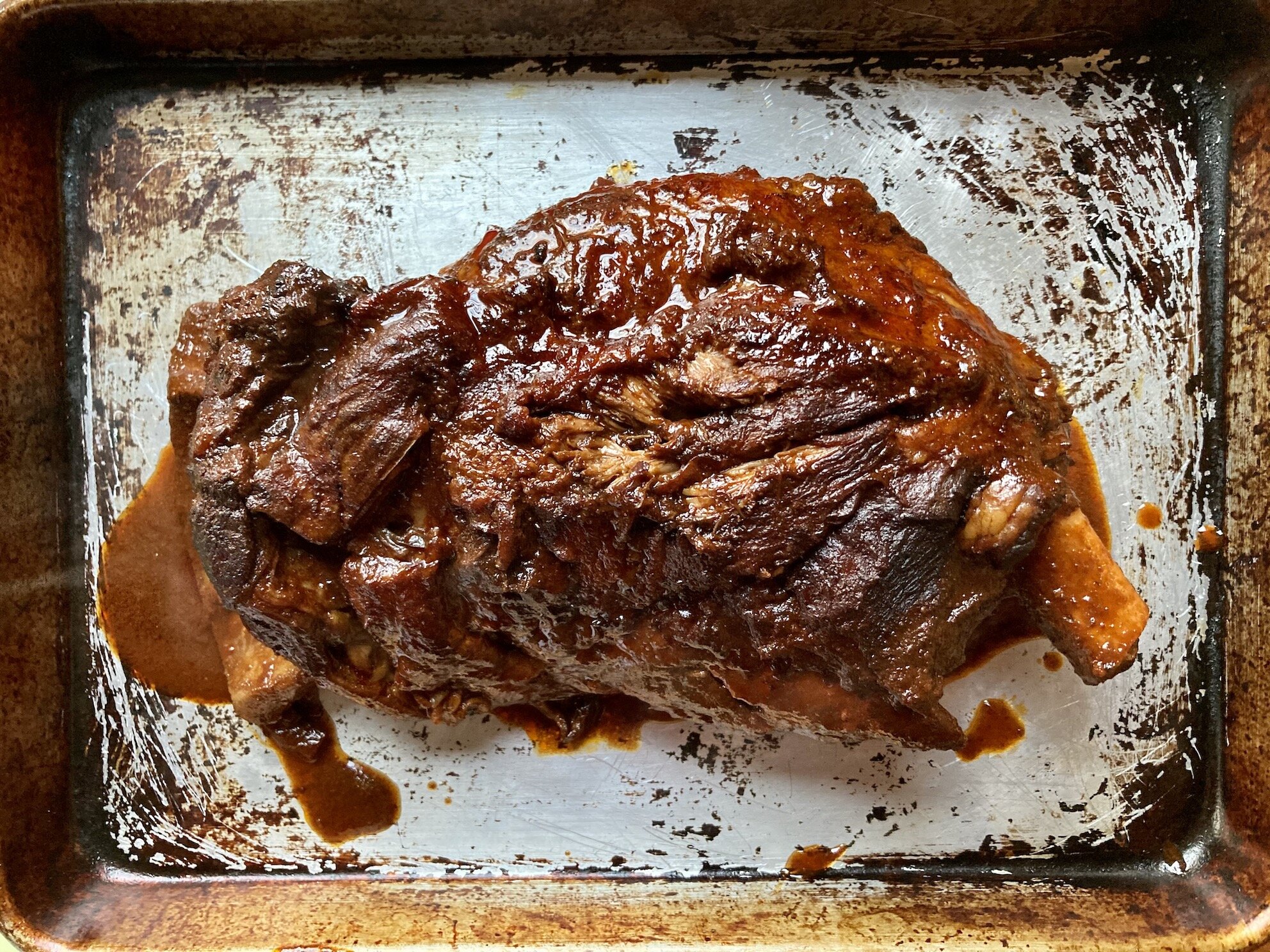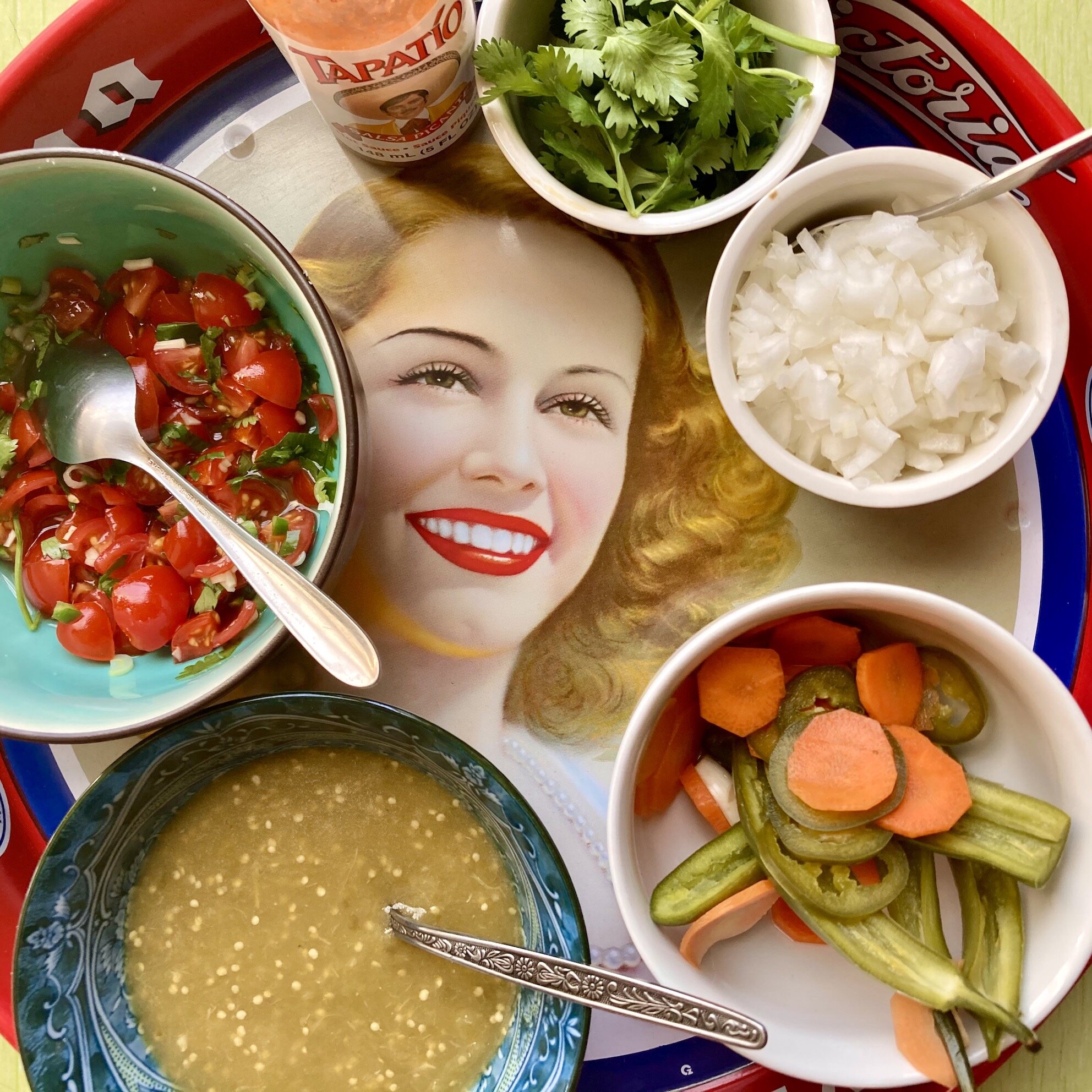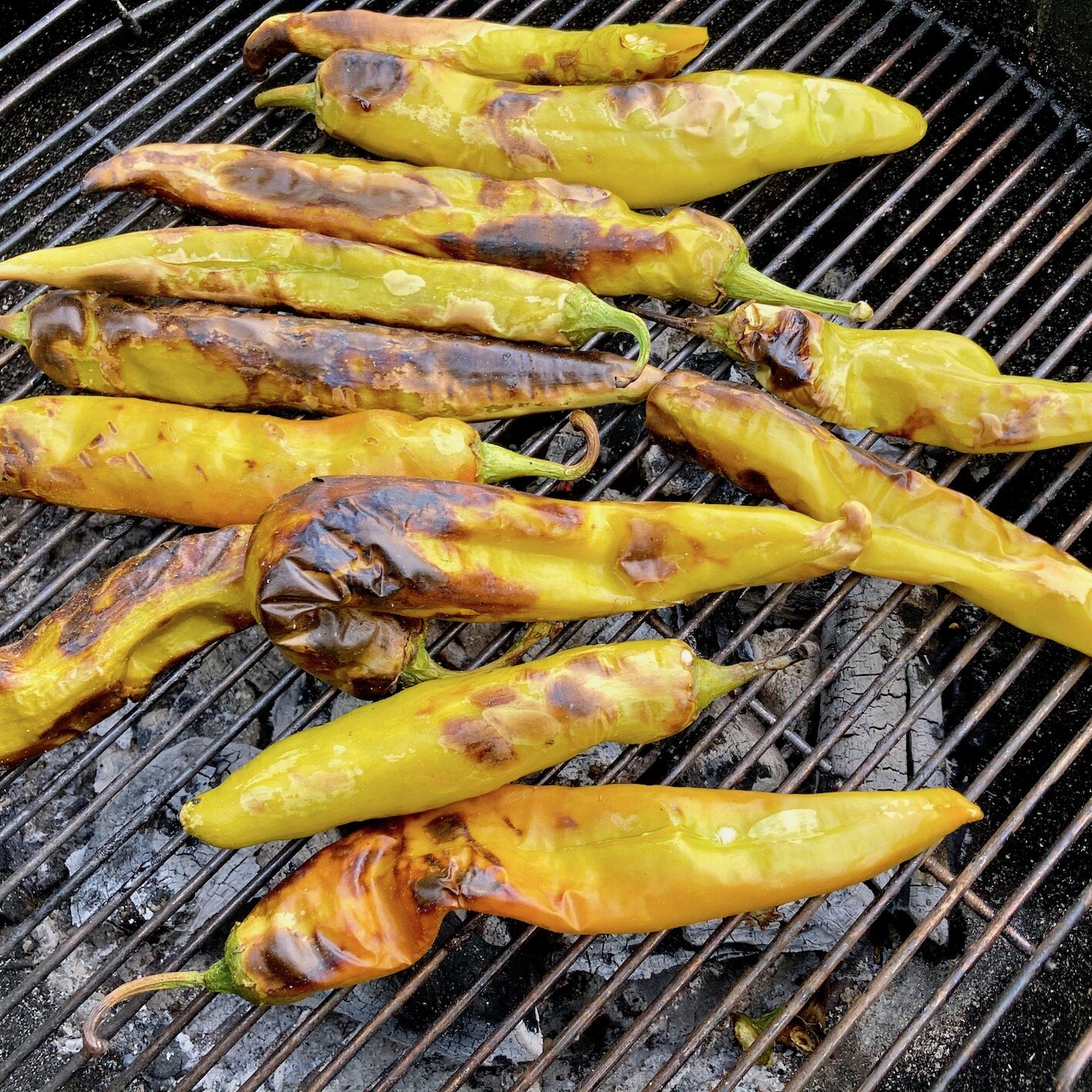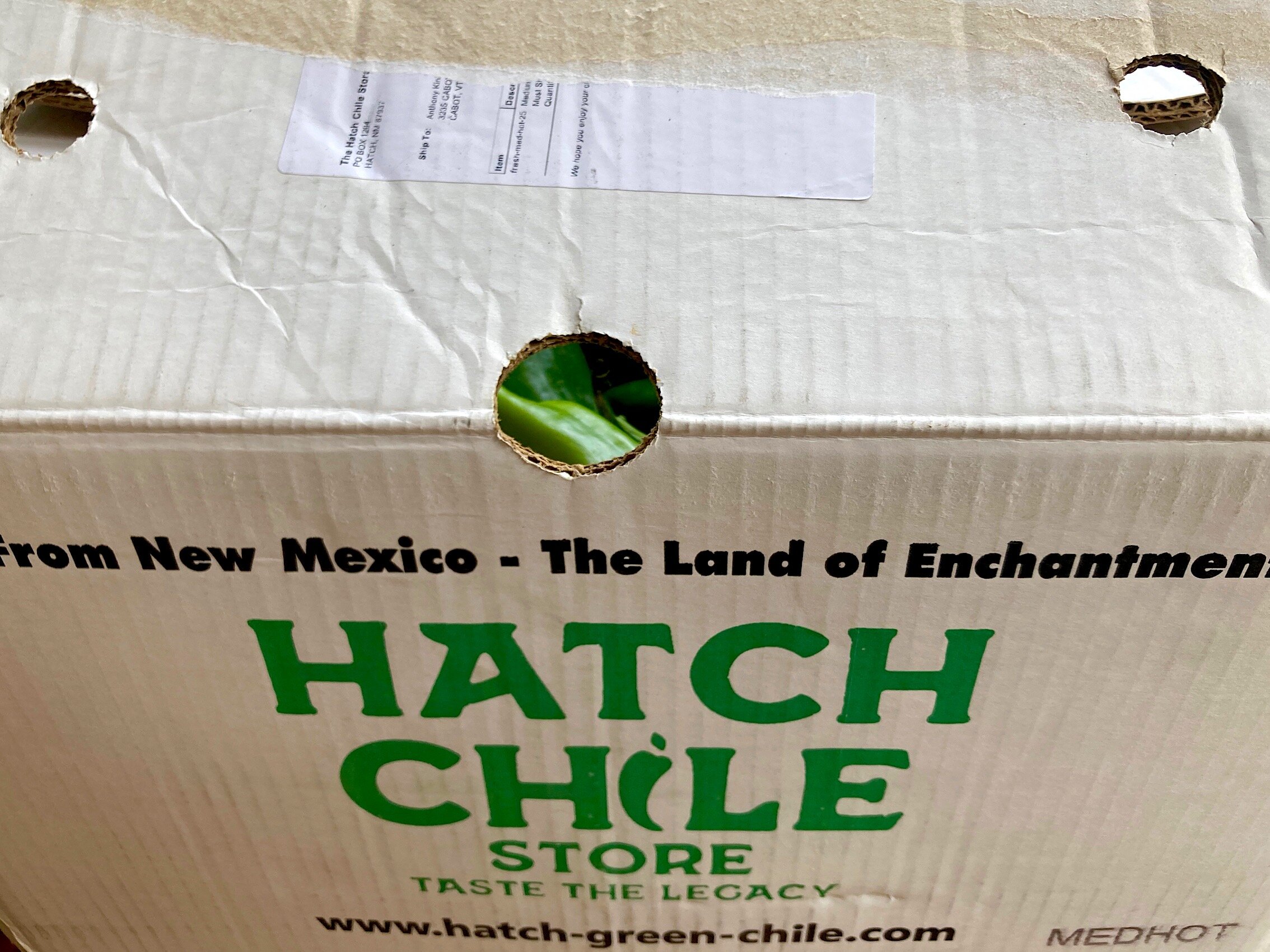This post first appeared in 2007. I guess that means it is celebrating its 15th anniversary. As you’ll see, it was prompted by the seasonal arrival of locally grown sweet and hot peppers of all kinds in Montreal’s markets—especially Jean-Talon. But there’s an unexpected soccer theme to it. I didn’t remember that aspect of this post, but its presence is somewhat ironic because the last time I made this dish was December 18, 2022, the day of the World Cup Final in Qatar.
This recipe has been a staple of our repertoire for at least fifteen years. It’s one of a handful of dishes that is guaranteed to drive Michelle crazy. You know, the kind of dish you literally can’t stop eating. This is one of those for her. It’s a dish she requests often. I prepared it for the night of December 18 because that was the day of Michelle’s 3001: A Cookie Odyssey/Christmas Market event, and that’s the way Michelle wanted to celebrate the occasion. She thought it would be a fitting way to close out the market’s Eastern European theme. She was right.
Did the idea to make Hungarian goulash this past week come from a recent re-viewing of R.W. Fassbinder's The Marriage of Maria Braun? Yes, the film integrates the utter hysteria that surrounded Germany's 3-2 victory over Hungary in the 1954 World Cup final seamlessly into its explosive finale, and, yes, I have been on a real Hungarian kick suddenly, making three Hungarian meals since watching Fassbinder's masterpiece of melodrama, but, c'mon... Truth is, the inspiration behind that goulash had a lot more to do with the current availability of peppers--fresh sweet and hot peppers from Jean-Talon Market, and dried peppers from Olives et Épices, also at the market. The dried peppers--whole Hungarian smoked hot peppers--we'd gotten a while back, and as soon as we gave them a whiff, we turned to each other, gave each other a couple of knowing looks, and uttered the word "goulash" in unison. The fresh peppers in question were Hungarian banana peppers and Hungarian sweet peppers from Birri. As soon as they came into season, I started thinking about all those pepper-heavy Eastern European dishes that I love, like Paprika Chicken, Slovak eggs, Bab Leves, and, yes, Hungarian goulash.
I turned to a recipe for gulyás from Saveur, where, unlike the dish that's come to be known as "Hungarian goulash" in North America, the consistency is more along the lines of a "soup that eats like a meal." The recipe seemed authentic and all--though it does include tomatoes, which some gulyás devotees strictly avoid--so I used it as a blueprint, but I made a few significant changes. First off, I was more in the mood for a stew than a soup (even one "that eats like a meal"), so I cut back on the broth and aimed for a thicker, more stew-like consistency, a somewhat authentic take on the bastardized North American version I grew up with (the kind that tends to get served in the presence of strolling violins). Secondly, inspired by the idea of those Hungarian cowpokes making their gulyásover an open fire, I decided to make an iittala casserole-bound version that could be cooked over an open fire, if you're the kind of ranch hand who takes Finnish designer cookware out on the range, or in our fireplace, if only we had one. Lastly, I left the potatoes out. And then I put them back in (you'll see what I'm talking about momentarily). But mostly I balked when it came to the potatoes. And I'm not 100% sure why. I told myself it was because I knew there was going to be enough to freeze, and sometimes potatoes don't freeze so well, but I never really found that line all that convincing.
So, this particular goulash might not win prizes for authenticity, but, as we all know, authenticity has its limits. The bottom line was that it was delicious--the cubed beef had turned to candy, and it had a deep, rich broth that was utterly irresistible (you know: the kind of dish that you just can't stop yourself from having one more bowl of, even when you're officially "full"). I was downright enthusiastic about my bowl. "This might just be the best goulash I've ever had," I remember thinking.* Then I went back and had three or four more helpings just to be sure. Michelle didn't have her bowl of goulash until she got off from work later that night and I assembled her late-night snack. Now, granted, she hadn't eaten in 12 hours, she'd just come back from a tough shift, and she was maybe just a little delirious, but she wasn't two or three heaping spoonfuls in before she turned to me, earnestly, and exclaimed, "This is my favorite meal ever." Like I said: she was a little delirious. But I knew what she was talking about. That pseudo-Hungarian goulash absolutely hit the spot. It's certainly well worth tracking down smoked hot Hungarian peppers and fresh Hungarian sweet and hot peppers for.
fig. a: Goulash with roasted potatoes
Goulash à la AEB (2022 version)
2 strips of thick-cut bacon
1-2 tbsp vegetable oil
2 yellow onions, peeled and chopped
2 1/2 lbs beef chuck, cut into 2" cubes
1 carrot, peeled, and coarsely chopped
1/2 tsp caraway seeds
3 cloves garlic
Salt and freshly ground black pepper
2 tbsp sweet high-quality Hungarian paprika
1 rounded teaspoon ground smoked Hungarian hot peppers (optional, although you could use a high-quality smoked Mexican chile in its place if those are more readily available--either way, this touch really gives the goulash depth, it also gives it an unexpected, well, kick)
4 cups beef stock, warm
1 medium tomato, peeled, seeded, and coarsely chopped (optional if you're one of those that believes that tomatoes have about as much place in a gulyás as they do in a chili)
3-4 fresh Hungarian sweet peppers
1-2 fresh Hungarian hot peppers
In a large Dutch oven, fry the bacon strips, rendering their fat. Remove the bacon, and dice the strips. Reserve. Add 1-2 tbsp vegetable oil, bringing your total amount of fat in your pot to 2 tbsp (or just over), and heat over medium heat. Brown the beef cubes on all sides, making sure to get a nice sear on them. Turn up the heat slightly if you need to in order to brown the meat properly. Remove the meat from the Dutch oven, placing it in a large bowl.
Preheat your oven to 300º F.
Lower the heat to medium-low, add the onions to the Dutch oven and cook, stirring occasionally, until soft, about 15-20 minutes. Add the carrots, the fresh peppers (both sweet and hot), and the reserved bacon, and continue to cook, stirring occasionally, until the peppers have softened, about 10-15 minutes.
Meanwhile, toast the caraway seeds in a small skillet over low heat until fragrant, about 1 minute. Crush the toasted caraway seeds in a mortar, add the garlic and the salt and crush some more until you have a paste [everyone knows about goulash and paprika, but this combination of garlic, caraway, and salt is just as essential]. Remove the pot from the heat, add the garlic/caraway paste, the paprika, and the smoked Hungarian hot pepper to the onion/carrot/pepper concoction and stir well.
Add the browned meat and stir well. Add the stock to the beef mixture, stir, and transfer to an oven-ready casserole. Add the tomatoes (if using), stir, and cover. Put the casserole in the oven. Bake for 1/2 hour at 300º F, then lower the heat to 250º and bake for another 2-3 hours.**
While the goulash is simmering to perfection in the oven, giving off the most other-worldly aroma, roast some potatoes, if you’re the kind of person who prefers potatoes with your goulash.
If you’re the kind of person who prefers spätzle, plan accordingly.
If, however, you’re happy to serve your goulash with egg noodles, relax.
When the goulash has finished simmering to perfection, season to even greater perfection with the salt and freshly ground black pepper.
If you’re serving your goulash with potatoes, place a spoonful of roasted spuds and ladle the goulash overtop.
If you’re serving your goulash with spätzle, spoon the goulash over a bed of spätzle.
If you’re serving your goulash with egg noodles, ladle the goulash over a bed of noodles.
In all three cases, I recommend topping off the goulash with a small dollop of sour cream.
Usually serves 4-6 hungry souls. I say “usually,” because it really depends who you serve it to. Michelle isn’t the only one who gets driven crazy by this goulash. I’ve seen perfectly civilized people go back for fourth and fifth helpings. You’ve been warned.
NOTE: Goulash often tastes even better on Day 2. I wouldn't necessarily recommend making it a day in advance, because, personally, I wouldn't be able to restrain myself, but, if at all possible, try and keep some as leftovers for lunch or dinner the next day. You'll be happy you did.
[adapted from a recipe in Saveur's "Food for the Holidays" Winter 2004 special issue]















![fig. d: “large, fleshy, [and] moderately hot”](https://images.squarespace-cdn.com/content/v1/5407bbece4b0d617570ff0ed/1600222923680-AGNH71HXWWX9Q1JLOWG8/sea+of+green.jpeg)

